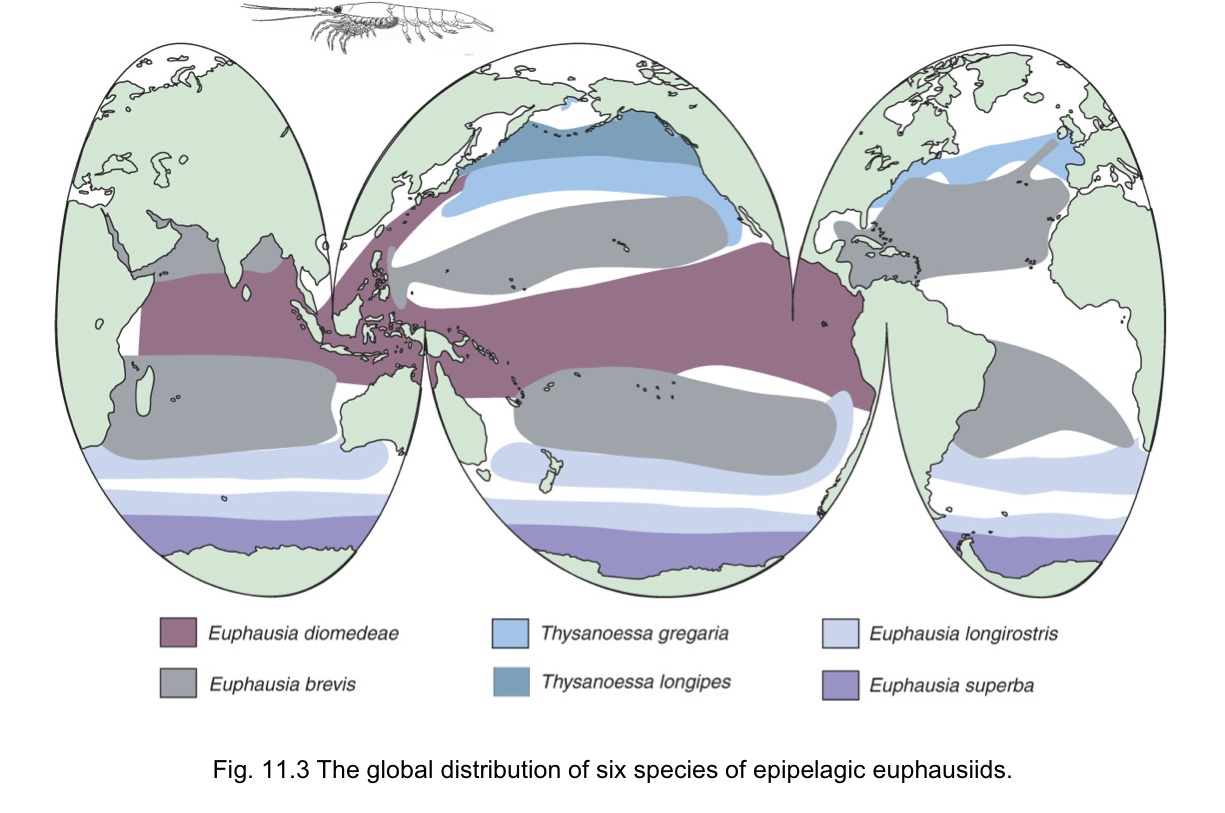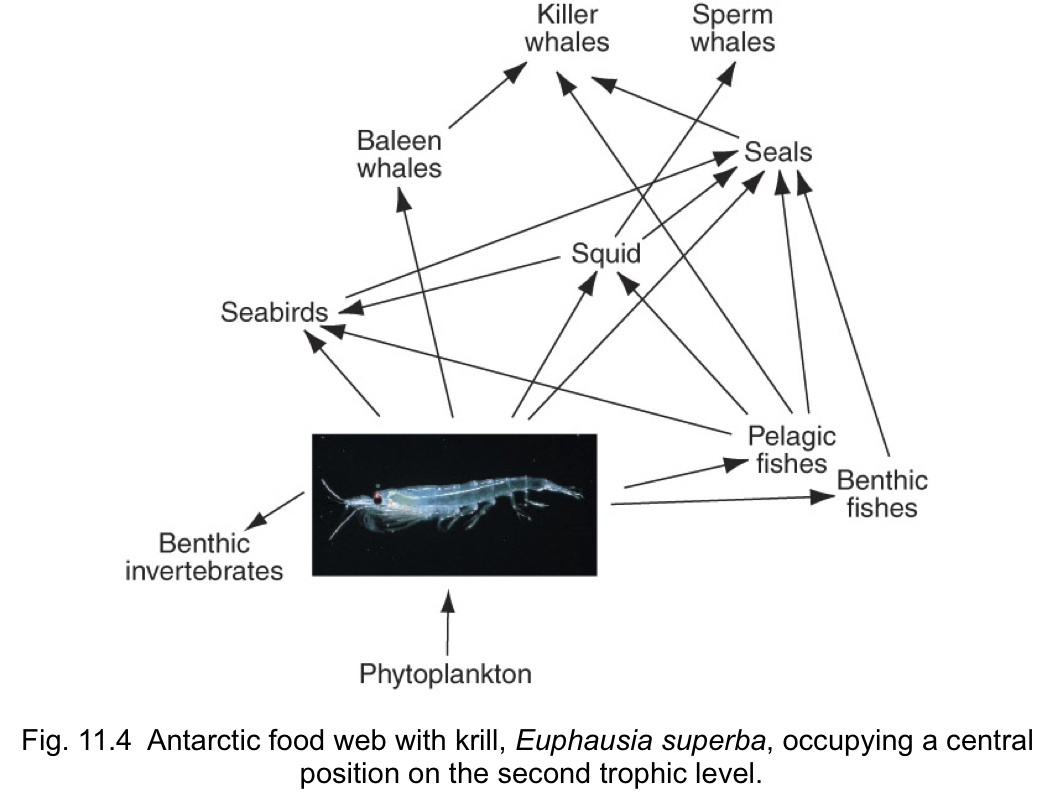This can be seen by looking at the distribution of six closely related species of krill

Krill are an essential part of oceanic food webs

| Dept of Biology, Lewis and Clark College | Dr Kenneth Clifton |
|
Biology
221 Lecture Outline |
Conserving marine resources: is sustainability achievable?
Further discussion of sustainable take from marine habitats: reducing consumption and establishing protected areasThe concept of sustainability: managed use of resources such that they are replaced at the rate they are depletedHow to achieve sustainable consumption?1) Reduce rate of consumption to match renewal rate2) Set aside areas (Reserves)Recycling may complement natural renewal (see coral reefs for a good example of this occuring naturally) Fisheries and Forestry science predicated on this aspect of resource managementSeafood Consumption and the role of consumers in determining what species are bought at what prices.
The role of ecology in the design of reserves:
Establishing reserves to provide relief from "take"Some basic concepts
What this translates into 3 needsCores and buffer zones
Nodes and corridors
So, why don't we have reserves all over the place?Representation
Replication
Connectivity
Do reserves work? Greater diversity and abundance inside?
Yes! Especially those BOFFFS!SpilloverYes! (but you need time) Marine Protected Areas (MPAs) and some examples: Read this pdf for background on the topic of Marine Reserves. (Required reading!)
Examples
California Marine Life Protection Act
Nationally, the US has established some significant zones of protection.
The Australian Marine Reserve System
In 2011, the Australian Government began to establish the largest marine reserve on the planet
The theory vs reality - the challenges of implementing a reserve Two examples:Ultimately, you need ecological knowlege to understand how to design and manage a reserveMaziwe reef - Tanzania
Oregon coast
The resources being protected be clearly defined and understood (remember your lessons from Bio 141)What else is neccessary for success:Think of the importance of basic biology (food/sex/death)
Species area curves
Population growth and recovery models
Community involvement vs exclusion
Restoration ecology: in principle vs in reality.
Science vs popular attitudes about certain species.
One last marine ecosystem: Polar regions
Polar habitats often have very rich nutrient levels that are seasonally productive.
Long seasonal periods of darkness reduce primary productivity to low levelsBiological diversity is lower than other regions, probably because many species cannot survive the extreme conditions.Freezing temperatures increase salinities... allowing marine waters to be < 0°C.
Polynyas are open spots of water surrounded by sea ice. These are important for air breathing marine animals.
Those that are successful tend to be very abundant. Whales make feeding migrations into polar regions in the spring, and leave for warmer waters before winter.
Some examples of polar marine biodiversity
Ice associated krill (Family Euphausiidae) are important grazers of algae that accumulate on the undersides of floating sea ice.
Icefish (Family Channichthyidae) have glycoproteins that act as antifreeze to allow survival at temperatures below freezing.A single krill can clear one square foot of ice algae in approximately 10 minutes.
They lack hemoglobin but in the low temperatures at which they live, their blood carries enough dissolved oxygen to surviveAntarctic toothfish (Family Nototheniidae) are the most common fish in the Antarctic.
Most are bottom dwellers feeding on invertebrates and occasionally algae. These fish are an important source of food for penguins, seals and toothed whales.Weddell seal, Leptonychotes weddelli, has thick blubber that allows survival in the extreme cold.
These seals attain weights of 900 to 1,000 pounds on a diet of fish and squid. They are eaten by killer whales
Leopard seal, Hydrurga leptonyx, a very large top-end predator with a vicious reputation (eats penguins and other seals, along with fish).
Polar bears (Ursus maritimus) hunt marine mammals and may swim long distances offshore. Climate change and loss of ice may threaten this species.
The Open Sea includes life forms associated with the "pelagic division" of the marine realm. By definition, this is away from the influence of coastal habitats.
The pelagic realm is a three-dimensional, nutritionally dilute habitat with low rates of primary production and few obvious physical niches.
Remember the parts of the ocean
In the open ocean, the divisions are linked to light levels
(Recall from lecture 2):
Epipelagic (upper 150 - 200 m or so... linked to the photic zone)
Mesopelagic (150/200 - 1000 m)
Bathypelagic (1,000 - 4,000 m)
Abyssopelagic (4,000 - 6,000 m)
Hadal (in the trenches)
Two major groups of marine animals in this region include the zooplankon and the nekton
Zooplankton are represented by more than 5000 species of:
permanent holoplankton (including all three protozoan phyla, cnidarians, ctenophores, chaetognaths, crustaceans, and invertebrate chordates)
meroplanktonic stages of invertebrates and fishes
Most nekton are vertebrates, and most marine vertebrates are teleost fishes.
Where is life found in the open ocean?
Within the center of the large, semi-enclosed, oceanic current gyres is the epipelagic, or photic, zone
Geographic patterns of distribution for life in the open ocean are broadly defined by unique combinations of water temperature and salinity
This can be seen by looking at the distribution of six closely related species of krill
Krill are an essential part of oceanic food webs
Given the 3-D nature of the habitat, also consider the vertical distribution of pelagic animals... most are near the surface in the epipelagic (photic) zone
Although the epipelagic zone accounts for less than 10% of the ocean’s volume, most pelagic animals are found there
Most are countershaded carnivores that are effective swimmers, so many species are more broadly distributed than the more discretely distributed zooplankton.
How countershading works:
Back to the Marine Biology Moodle Page